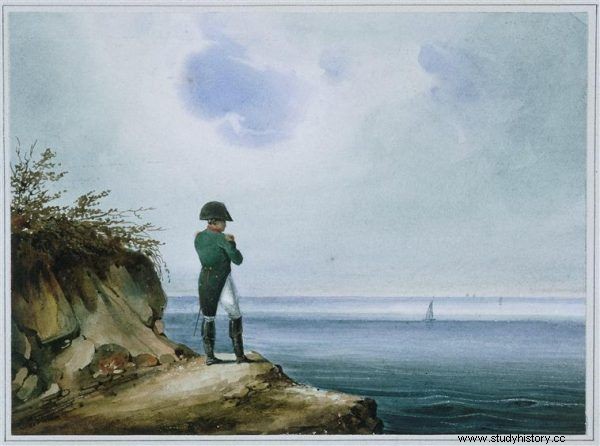The postmortem diagnosis indicated stomach cancer, but later studies indicate that the reasons for the death of the involuntary resident of Saint Helena could have been different ... Did Napoleon die of disease or someone sped up nature?
Napoleon achieved everything in life, but luck quickly turned away from him. In 1804 he became Emperor of France, gaining the recognition of his subjects by reducing crime, improving the economic situation, reducing unemployment and ensuring access to education for children. But eight years later, after the unsuccessful invasion of Russia, opponents of his rule formed a coalition and headed for Paris. In 1814 Napoleon abdicated. Later it was only worse - he suffered a crushing defeat in the famous Battle of Waterloo and turned himself into the hands of the British for fear of being shot.
This is how he came to the island, which would soon become the death site of the great leader. The only question is, did he die of illness or if someone helped the politically inconvenient resident?

Napoleon is one of the most fascinating characters in history. Emotions are also controversial over his death.
Deadly boredom
As a prisoner, Napoleon was terribly bored. He took 1,500 books with him to the island. But he himself said he should have taken nearly sixty thousand. He exercised daily at least in the early days, he also played cards and dictated his memories . He did not abuse alcohol, washed regularly, and stayed away from doctors. He rode a horse to the port, where he talked freely with people. So he had a lot of freedom, which quickly turned against him…
The governor, Sir Hudson Lowe, was in charge of keeping Napoleon on the island. He learned that Bonaparte's supporters were preparing an expedition to the island to rescue the prisoner . Napoleon's brother Joseph himself was to lead this undertaking. Therefore, Lowe, fearing that the valuable prisoner would escape, decided to limit his possibilities of contact with the world. Napoleon himself took this apparently as another campaign and began to constantly deceive his persecutors. He didn't show up when the guards came twice a day to confirm his presence. Not only that - ordered his servants to dress in the same way as himself, so that the observers would not be able to recognize where he is currently . Apparently for Napoleon, the fears of the governor were a great excuse to simply kill boredom.
Finally, Lowe decided that Napoleon had to be accompanied by guards on every trip to the harbor - which, of course, was not to the prisoner's taste. So he stopped riding, and later also stopped walking. This soon resulted in weight gain, swelling, headaches and bleeding gums . Napoleon's health deteriorated to such an extent that at this point one might assume the influence of third parties ...
Razor in the stomach
Napoleon first complained of his ailments on September 20, 1817. Then he felt a very acute pain in his torso, which he compared to cutting with a razor. His condition worsened significantly - his heart rate became irregular and his limbs became unhealthy . This situation lasted a very long time. Napoleon, however, was so afraid of doctors that it was not until 1820 that he turned to a representative of this profession for advice. Archibald Arnott, however, for some reason assured the prisoner that it was only gases and after taking the medicine, the ailments would surely pass.
In the spring the emperor was vomiting and delirious . The content he returned looked like coffee grounds, which is obvious evidence of gastrointestinal bleeding. He was hallucinating His first wife, Josephine, had revealed himself to him to announce that they would soon be together again. He died on May 4, at the age of fifty-one.
Long before his death, Napoleon ordered an autopsy. Eight British surgeons and ten French supporters of the emperor were present at the inspection. Near the pylorus was found, according to the report from the section:
[…] an ulcer that penetrated the stomach lining, creating an opening equal to the thickness of the little finger. The inner layer of the stomach wall was almost entirely covered with cancerous or fibrous tissue from which cancer could have arisen [...]
It was clear, then, that it was precisely because of this that Napoleon suffered and later died. The agony was prolonged because the liver stuck to the opening in the stomach, obstructing the flow of the contents into the abdominal cavity. And yet, it turns out that the diagnosis of the doctors of that time could have been incomplete ...

Napoleon on Saint Helena
A trace in the hair
Dr. Sten Forshufvud was an admirer of Napoleon. He lived and practiced in the 1960s, he was a dentist. After reading all the available descriptions of Napoleon's ailments, he concluded that not everything was correct - among the symptoms there were as many as out of thirty possible symptoms of arsenic poisoning . As the exhumation of Napoleon's body for research purposes was out of the question, the inquisitive doctor went to Saint Helena and found numerous samples of Bonaparte's hair. The analysis of the arsenic content showed that the d limit level of the dangerous element is exceeded even 100 times! A series of studies began in which scientists also looked at the hair of Josephine and Napoleon's son. In each of these cases, the results were similar.
What's the truth? While Napoleon's wife and son could consume arsenic-containing drugs, the emperor himself did not use this kind of "medical service". However, he was known for his love of cleanliness, and many cosmetics of that time contained a poisonous element. The question of whether the arsenic concentration in his hair is evidence of a poisonous activity will probably remain unanswered forever ...
